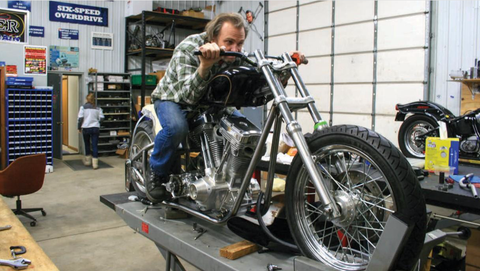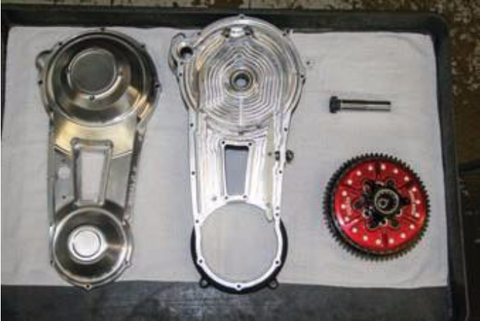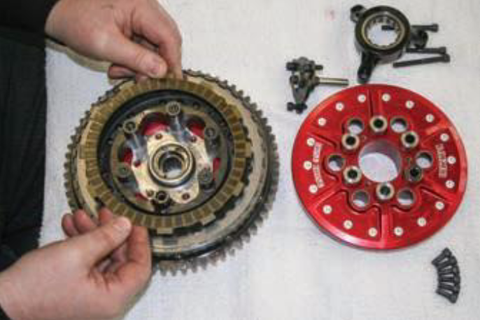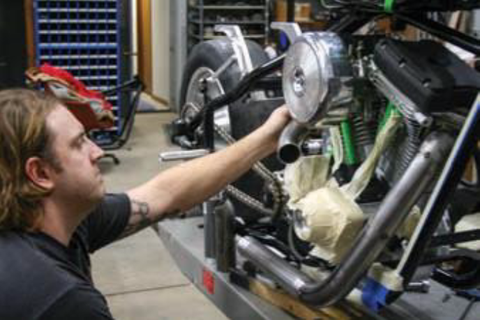In our most recent From the Vault feature, we got a sneak peek at Bert Effin’ Baker’s plans to build a ¼ mile speed demon from scratch with his brain trust of component experts. The Organ Donor is custom designed down to the last details to be a blood-pumping, adrenaline-coursing, thrill-inducing pure drag race motorcycle that delivers the goods.
In today’s edition, Bert and his wonder team get to work on the engine and drivetrain for the Organ Donor murdersickle. If 139” Kendall Johnson engines and S&S 675 camshafts don’t get your motor running, hand in your motorcycle endorsement and get a bus pass. Let’s get cracking:

Part two of the Organ Donor saga is devoted to the engine and drivetrain. The task of reporting the steps in the build process of the Organ Donor is very frustrating because there are so many details and tricks to building a bike, especially one with mechanical purpose and ¼-mile intent. Without seasoned help from the gearheads at BAKER, and individual component experts, this project would have taken me three years instead of three months.
If I were to chronicle all the details I learned from these seasoned experts to make this article a how-to-build-your-own V-Twin rocket, it would fill this whole magazine. Keep in mind this is a Harley-based machine, which means it’s towards the simple end of the technology spectrum. It’s not a space shuttle!
Nevertheless, there are many methods, techniques, and skills that only come with time and experience; you can’t Google this crap. If there are questions on what we did, or how we did it, give us a call or look us up at a bike rally.
You won’t see much of me in the photos of this article because I was, A.) the guy behind the camera playing porn director, B.) whipping out the 38-odd brackets and gizmos on the 2-axis CNC Bridgeport, and C.) playing camp counselor and head custodian at a company that makes transmissions and drivetrain products. But believe me, I was there.
Serious big displacement engines started showing up about 10 years ago when the custom chopper scene was going bonkers. Most of these 131+” big block engines found their way into overweight custom choppers that were never really let out of the stable. With the decline of the custom chopper, the popularity of the big block motor waned, simply because these big motors don’t fit in a regular frame without a chassis modification.
However, use of these oversized thermodynamic contraptions is on the upswing due to the fire-and-brimstone preachings of performance freaks like the previously mentioned James, Reverend George Bryce, and Don Vito Reggie Ronzello. George has a big shoehorn down in Georgia and is stuffing the S&S 145s into “converted” baggers. He can’t build them fast enough.
Reggie up at R&R in New Hampshire is doing the same with his big, potent, beautifully constructed “godfather” motors. Down in Alabama, Viper is making a 152” big bore short stroke Ilmor-powered production bike. I like the idea of monster motors going into bikes that are ridden (instead of parked and washed) even if the bike is an obese 800-pound behemoth.
For the Organ Donor, we used a 10-year-old Kendall Johnson-built 139” engine with 4 ⅜ bore and 4 ⅝ stroke. It had tall deck S&S cases, Axtell cylinders, aluminum rods, and S&S B1 heads with stainless steel valves. Due to the age of the motor and the unknown condition of its inner workings, we made the decision to tear it down, inspect things, and rebuild it with good stuff.
One of the cylinders was scuffed up, so we went .020” over which put the displacement at a solid 140”. We relied on the expertise of Axtell to bore the cylinders and fit new pistons. The new rings were ready to install and required no end-gap tweaking.
The flywheels that came out of the engine had 8” aluminum rods, a suspicious early crank pin with an aluminum expansion plug, and .012’ runout on the pinion shaft—so we sent them off to Mike Ligenfeld at Silver Moon Cranks in Wisconsin to get them right. Mike used a set of Dale Nungesser steel nitro rods with the rebuild per our request. He got the shafts on both sides within .001” runout, so I would say he is very good at his craft.

Mike pressed a new crank pin with a steel expansion plug in the flywheels and welded it into place. Because the original rods were aluminum, a lot of Mallory or “heavy metal” (Tungsten) had to be added to the wheels to re-balance them.
With the flywheels back, the engine assembly began. Thankfully, James is an experienced engine builder so he had the knowledge and all the crazy special tools necessary to do the job. Scotch-Brite Mark got the motor cases prepped and James pushed the left side case half onto the crank. The left side bearing end play was checked and deemed good so the right side case half was pushed on with some Three Bond 1104 in between the case halves.
We selected an S&S 675 camshaft because of the big displacement and 12.9:1 compression ratio. New hydraulic lifters were used with travel limiters. A new S&S HPHV oil pump was also installed, because the pump gears from the old pump were a little sticky and it would be silly to cut costs with this much invested in the motor.
The detailed ritual of priming the oil in the bottom end was performed to make it easy for the motor in its first few moments of life. We got base and head gaskets from Cometic to dial in the combustion chamber squish. The desired squish of .040” was verified with lead/tin rosin core solder and clay. The decision was made early on to use 12 point ARP fasteners throughout and this presented a special challenge because the flange on the head is much larger than conventional bolts. In some cases we turned down the bolt flanges and in other cases, like the rocket boxes, we interpolated the fastener pocket.

Below the Mason-Dixon Line there are tens of thousands of fellas named Jim-Bob, but in Michigan there is only one and he is the man. JimBob Haines runs HighOutput Engineering in Clarkston, Michigan and is considered the Winston Wolf (movie: Pulp Fiction) of CFMs by Greg Gates. That referral was good enough for me!
He replaced the stock 2.100” tulip stainless steel intakes with 2.150” nail-head titanium vales and unshrouded the combustion chambers to make these cylinder heads scream. The use of titanium allowed JimBob to reduce the seat pressure from 240 pounds needed for the stainless steel valves to a more sane 160 pounds on Moldstar 90 seats, which is a lot less destructive to the seats, is more durable, and allows for easier cranking.
The coil and ignition came from Accel/Mallory and the lime green plug wires came from Sumax to match my Kawasaki green mojo. The Cycle Electric alternator stator we used was one of those parts that you hold in your hand and it screams American-made quality. It also features robust terminal ends that solve the problem of arcing between leads on stock stators.
Andy Friar is the Baker production and engineering manager by day, but he got the nod to fab the pipes. Fabricator Friar, so named by Fabricator Kevin, is a talented fabricator and fussy TIG welder, exactly what this job needed. He used 2.25” OD pipes to plumb the exhaust gases out of this 2.3 liter engine. Routing two massive 2.25” pipes around the right side and making it look sanitary was easier said than done.

We used a 36” runner length for front and rear pipes, which might be shortened after some dyno and track time. Notice that the front and rear pipes don’t appear to be equal length, but they are.
Our own Function Formed Primary (FFP) and King Kong Clutch (KKC) were used for this machine. This primary drive was specifically designed for big power applications with the inner and outer primary housings made from thick-walled forging.
It utilizes an outside bearing support spider that bolts to the KKC and effectively supports the transmission mainshaft from flexing under big power. The KKC has 20 one-sided clutch plates that are 1.15” larger in diameter than stock and holds up to 250 ft-lbs with the heavy springs installed. Keep in mind that it’s torque, not horsepower that puts drivetrain components to the test.
A 24-tooth non-compensator ½” offset motor sprocket was used with a 37-tooth clutch sprocket, 19-tooth tranny sprocket and 41-tooth wheel sprocket to yield a 3.33 ratio. This ratio will probably be tweaked once I get to the track, but 3.33 is a good start.
A 6-speed Z-Ratio Right Side Drive TorqueBox with a 2.61 1st gear was used to transfer the power from the clutch to the rear wheel because it can handle up to 250 ft-lb of torque; The picture shows the size difference between a stock and a TorqueBox maindrive gear. It comes standard with a neutral switch, ignition kill switch, and N1 drum with a N-1-2-3-4-5-6 shift pattern. Tommy Fudge, our production foreman, is shown assembling the Organ Donor’s TorqueBox.
The next installment of the Organ Donor story will cover the final assembly. It may take 30 minutes to build a bike on TV, but I assure you that it takes much longer to do the job in real life!
